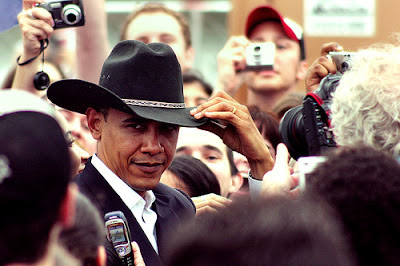Note: Probably
the most popular post ever on this blog in its early days on LiveJournal was posted during the 2008 Presidential Primary season. Yet it was only tangentially about politics. It was about…cowboy hats. The reason for
the popularity was the many links to great photos of old time movie and TV
cowboys. I seldom include many links any
more in posts—it’s too much work and I have grown lazy. But check them out here.
The other day I
spied a photo of Barack Obama campaigning in Texas
in a cowboy hat. Like most tall,
thin men, he looked good in one. Of
course that didn’t stop a lot good natured—and some decidedly not good
natured—mockery around the web.
Obama was just
trying on the quaint native peasant costume, a time honored tradition among
politicians. A particularly famous photo
of Calvin
Coolidge in a Sioux war bonnet
comes to mind. Obama didn’t let the
brouhaha that erupted after old photos wearing a white turban and tribal robes
in Kenya
dissuade him from going Texan.
Cowboy
hats carry with them a lot a symbolism.
Maybe even more than some suspect.
Put George
W. in one and you get the immediate queasy feeling that he just snuck
his daddy’s guns out of the closet and is off to see what he can shoot in the
brush. Ronald
Regan instantly invoked the folksy hero of B Westerns (think Cattle
Queen of Montana) and the
host of low budget TV oaters (Death Valley Days.) The homespun cowpoke image helped voters
overcome misgivings about his conservative economic policy and hawkish foreign
policy. Lyndon
Johnson’s familiar Open Road
Stetson reinforced the image of a Texas
wheeler-dealer—think ruthless cattle baron or an oil wildcatter with an eye out
for the main chance.
What
got my attention was Obama’s choice of a black hat. It seemed symbolic of his breaking free of
many of the old constrains and preconceptions that have separated Americans in
to hostile camps. Let me tell you why.
Way
back when I was a boy in Cheyenne,
Wyoming, I used to run home from school every day to watch Pete
Smythe, Mayor of fictional East
Tin Cup, Colorado on Denver’s KOA-TV
introduce old two reel Westerns—Tom
Mix, Hoot
Gibson, Tim
McCoy, Ken
Maynard, Gene
Autry, Tex
Ritter, Wild
Bill Elliott et.al. A great deal
of my moral development came from absorbing these films and the wisdom ol’ Pete
dispensed in his introductions. I
remember with perfect clarity the day Pete explained the Rule of the Hat--“Good
guys wear white hats. Bad guys wear
black ones.” I was skeptical at
first. But film after film showed me it
was true. The hero almost invariably
wore a big white hat.
Oh,
there were rare exceptions. Bill Boyd as Hopalong Cassidy was decked out in
black from his 10 Gallon Hat to his
boots—but he balanced that by riding the whitest horse in the oaters. Later on TV Hugh
O’Brien as Wyatt Earp would
wear a black hat. But he wasn’t really a
cowboy—he was a lawman. And he was outfitted
in the long black frock coat, brocaded vest, and string tie that that had been
the trademarks of the saloon keeper villains of the old two reelers. I didn’t realize it when I was watching that
show at the time, but the costume was a hint at the real Earp’s somewhat shady
reputation as a faro dealer and part time pimp.
More
recently, black cowboy hats have come into vogue among those who fancy
themselves rebels and outsiders—think NASCAR’S
late Dale
Earnhardt or country music bad boys like Waylon
Jennings or Hank Williams, Jr. But these are just good guys pretending
to be bad. The black hat works because
it is ironic and because in the back of our minds we still associate a black
hat with a bad guy.
As
a Black man running for President he has already smashed stereo types and
expectations. As an already iconic Good
Guy himself and the oracle of Hope
and empowerment (Yes We Can!) he can
don a black hat and casually demolish another.

No comments:
Post a Comment